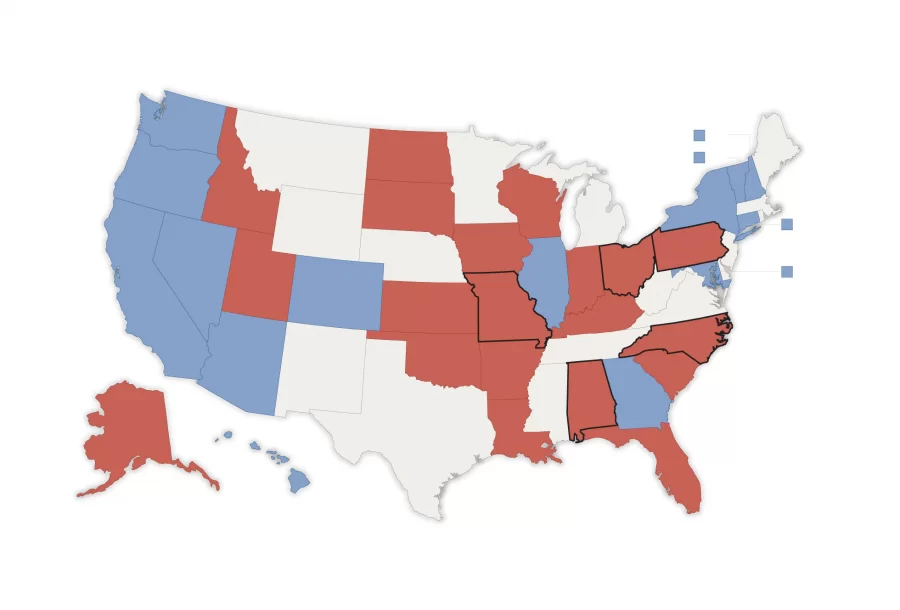Looking Ahead to the Midterms 2022: Why You Should Care
October 20, 2021
It’s still 2021. Trust me, I know. I know that the Midterms aren’t until Tuesday, November 8th, 2022. With that said, there is still plenty of political action to happen from now until then. A lot has happened in 2021, and there is still plenty of year left. From the January 6 insurrection to the inauguration two weeks later to the resignation of New York Governor Andrew Cuomo in August, this year has been eventful to say the least. These events, and more, are sure to bring heavy debate between members of the House of Representatives, the Senate, and even potential presidential candidates for 2024 general election.
What is the Midterm?
The Midterm election occurs approximately halfway through the term of the current president. All members of the House of Representatives are up for election, as well as 34 Senators. Numerous key local issues will be placed on the ballot as well. These include criminal law modifications, tax levies, or changes in civil laws. The main difference from the presidential election is, of course, that there is no presidential candidate on the ballot. With that in mind, fewer people are likely to vote in the Midterms. In the 2018 Midterm, 53.4% of eligible voters cast their ballot, compared to the 66.8% that did so in the 2020 presidential election. That 13.4% difference can sometimes change the outcome of elections because so many fewer people vote. That’s why during Midterms, as well as during every other election, it is crucial to cast your ballot. It is the only way that the winner of an election can surely be the result that a majority of the people favor.
The Midterm election provides another key insight. It can show the people’s view on the president so far in the term through how certain swing districts and states vote. Generally, the results favor the party that lost the previous presidential election. So far, with limited polling data, this trend seems to ring true, as the results favor the Republicans more than in 2020. In an Iowa presidential approval poll in September 2021 by the Des Moines Register, 31% of voters approved of the president’s performance, while 62% did not. Iowa is notorious politically for several reasons. It is the first state to have a primary election for the president, as well as being considered a “swing” state. In 2020, Trump won the state by approximately 8% (53.1% to 44.9%). That means that the recent polling data should give Democrats pause.
Why does this matter for the Midterm?
Although early, the Iowa poll of presidential approval can give a hint to what voters will decide in 2022. Typically, voters will vote for the same party in all elections, local or national. The main exception would be in 2020, when large numbers of Republicans voted for Biden but still voted for a Republican House member and/or Senator. Considering that Trump will not be on the ballot in the 2022 Midterm election, the Republicans that voted for Biden will likely vote Republican again.
What is at stake?
America is divided. In the Senate and House, it’s like pulling teeth to get anything passed, and the Democratic majority in congress is incredibly thin. The Senate is currently tied at 50 (R)-48 (D)-2 (I), with the Independents voting as Democrats. The House is the other way around, at 220 (D)-212 (R). With such small majorities and a large portion of congress up for election, the power balance can change quickly. The Republicans only need to flip one seat to gain the majority in the Senate, and five to do so in the House. Should the majorities change, much of the president’s agenda could be stopped, creating gridlock until 2024 at the earliest.
Why should You care?
No matter the party, a lot of good or bad can happen in the upcoming election. Democrats are trying to hold on to both houses, while Republicans are looking for redemption after 2020. If you are 18 or older, it is crucial to vote, especially considering how divided we are as a country currently. If you are 17 or older, you can volunteer at a polling location (there are approximately 230,000 polling locations (as of 2018) that need poll workers to help people cast their ballots.) If you are 16 or under, although you can’t vote, you can easily encourage others who are eligible to do so. A vast majority of current high school students will be able to vote in 2024, so it is important that all have some sense of political awareness when that time comes.
For now? Stay tuned! If 2020 and 2021 have taught us anything, it is that there is plenty to come from now until November 8th, 2022. So, sit back, grab your popcorn, and enjoy the election season!


Ryan • Oct 20, 2021 at 11:34 pm
Nice
Zain Anwar • Oct 20, 2021 at 10:14 pm
Incredible job Brad!